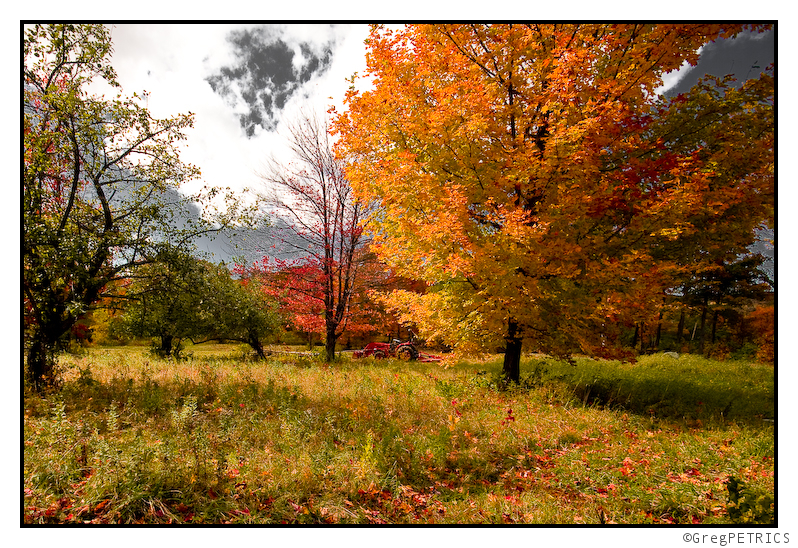Capturing the Brilliance of Dying Leaves
Anyway, moving on, here is the shot you were supposed to see. A beautiful Vermont meadow lying fallow surrounded by brilliant foliage. Notice how the careful placement of the tractor confuses the viewer by forcing the law of thirds to do battle with the law of halves—creating at their point of intersection, the law of sixths—to suggest the eternal struggle between man and nature.

Click to Enlarge
Another trick often used by skilled photographers such as ourselves to help the viewer “step into” a photo is the judicious use of the so-called “vanishing point“. For those of you who failed middle school art, the “vanishing point” is the term which is used to describe the optical illusion that straight lines heading away from one’s viewpoint apparently converge at a point in the distance. First discovered in the Renaissance (before which time the entire world was shaped liked an M.C. Escher drawing), this trick can be used to guide the viewer’s eye to the subject of your photograph, such as in this gem which uses the vanishing point to help the viewer interpret the post modern struggle of man versus machine.

Click to Enlarge
Here we see the same effect being used, but this time the emphasis of the leaphoto is on man’s embrace of physical law and his symbiosis with machine as he commands the universe.

Click to Enlarge
Here is the exact same thing, but I made sure to use a polarizer to boost the saturation because it looks cool.

Click to Enlarge
In the next one we see what Eric Clapton was talking about in the song After Midnight, when he belts out “It’s what is all about… it’s what it is all about…”. He was talking about the Vanishing Point.

Click to Enlarge
Read about the author: Greg
5 Comments






Kingsley
wrote on October 22nd, 2009 at 9:35 pmSolid work dude. Mathgeek/photogeek/wordsmith AND FIS? Damn.
sfmornay
wrote on October 25th, 2009 at 1:00 pmGreg sez:
” … this gem which uses the vanishing point to help the viewer interpret the post modern struggle of man versus machine.”
Thanks for clearing that up. I had convinced myself that it represented the spiritual crisis resulting from the intellectual paralysis brought on by confronting the physical inevitability of Zeno’s paradox.
Sam
wrote on June 21st, 2010 at 1:24 pmsomehow I didn’t catch that the first time around. You really need to comment more often, that was awesome!
Greg
wrote on October 25th, 2009 at 1:42 pmNo problem… the autonomy of art though lets us both be right :D
Anonymous
wrote on October 18th, 2010 at 12:14 amAMAZING. Never really found someone who loved winter as much as me. SoulMates?